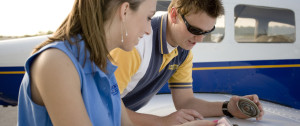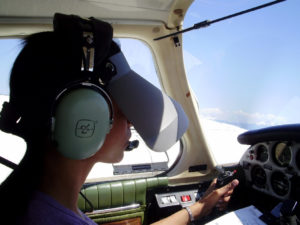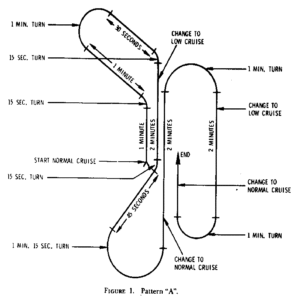A fellow CFI recently asked my thoughts on whether instrument flying is more art or science. Long story short, I’m of the opinion that it’s a bit of both. While ruminating on our conversation later that day, I stumbled upon this post by John Zimmerman, where he declared it to be the former and asked an interesting question:
Why do we insist on a robotic approach when it comes to teaching instrument flying?
I’ve heard that about many things in the world of flight training: “It’s too robotic/regimented/boring/skills-driven/etc.” There’s a good reason for that. Learning to fly is like learning just about any highly complex activity, whether it’s ballroom dancing or open heart surgery: by using a proven and well-structured “building-block†approach. Individual skills are taught, demonstrated, critiqued, and practiced until they become second nature. Then they are added to and combined in order to allow the final activity to be performed reliably within the requisite standards.
Are there other ways to learn how to fly? Of course. The variety of strategies for accomplishing the task are as numerous as stars in the sky. They range from literally militant (in the armed forces) to so freeform that there is, for all intents and purposes, no structure whatsoever.

I’ve previously theorized that not only could a person learn to fly without a “robotic approachâ€, they could learn to fly without an instructor at all. The Wrights did it. Even today in the United States, there are places where people teach themselves to fly. One of those pilots later became a student of mine, and he flew beautifully. On the other hand, I don’t think that was a typical example. But it shows that there are countless ways of achieving the goal of teaching someone to fly, whether on instruments or visually.
When it comes to flying, I would add that we’re not only searching for the most efficient (and therefore least expensive) method, but also the one which creates a safe pilot. Primacy of learning dictates that students be taught the proper way to fly by instruments from their first attempt, lest they later fall back on unsafe methods when under stress. This is something we as teachers have known since Edward Thorndike developed the first “laws of learning†a century ago.
I don’t mean to dump on Zimmerman’s post. On the contrary, he provides some excellent suggestions. The “essential profiles” tip is, in my experience, one of the big keys to success in instrument flying.
You should memorize the key power/flap/gear/airspeed configurations for each airplane you fly, including max climb, initial approach, and final approach. For example, if you know that 20 inches of manifold pressure and 10 degrees of flaps will deliver 100 knots in level flight, set that configuration outside the final approach fix and get back to flying. Then, as you approach glideslope intercept, you can fine tune it if needed. It’s a great way to reduce workload at critical times, and can also bail you out in an emergency.

Once you’ve got power settings memorized for level cruise, precision descent, and non-precision descent, it makes flying so much easier. This is especially true when flying approach procedures, which is where the most precise flying is required. You set the power and the plane does what you want without all the usual jockeying of throttle, pitch attitudes, and so on. Once you’ve got the airplane on speed in level flight, you set the power and the airplane maintains the trimmed airspeed without any further ado. Memorizing power settings is one of the very first things I have an instrument student do. If that sounds a lot like what you’d do if teaching someone to fly in VMC rather than IMC, you’re on the right track.
I’m continually amazed at the number of instrument-rated pilots who never learned the profiles for their aircraft. It takes me about two minutes flying with them in actual or simulated IMC to notice it. I don’t understand how anyone can reliably fly within the PTS/ACS standards without knowing those numbers. Oh, they may stay on, say, the localizer and glideslope. But the airspeed will almost certainly be all over the place.
Even in a large cabin business jet like the Gulfstream IVSP, I know EPR numbers and/or fuel flow ranges for various configurations and scenarios. I say “ranges†because the airplane is much different at 49,000 lbs than it is at 75,000 lbs and the settings will vary accordingly. Likewise, for any aircraft — even the lightest of instrument trainers — the power required to fly a precision glidepath at a constant speed will vary somewhat due to the effect of wind on the aircraft’s groundspeed.
Teaching instrument flying got a lot easier for me once I realized that you do the same things you’d do with a VFR student pilot – and in much the same order, too. Would it makes sense to start a neophyte off on his or her first lesson by working on landings? Of course not. But that’s what instructors often do with instrument students, flying instrument approaches on day one. Why? I’ve heard answers ranging from “because it’s more interesting for them†to “it’s the most critical skill so they need more time working on itâ€. The truth is you’re asking them to perform open heart surgery without any medical training.

A better (and admittedly more “roboticâ€) strategy would be to begin with basic aircraft control: level flight, climbs, descents, and turns. Once that’s mastered, combine them with more complex instructions involving climbs and turns, level offs at odd altitudes (3,650’) and unusual headings (“237 degrees, please”). Challenge their skill level by introducing an alternate scan via partial panel. They got that down pat? Add in constant rate climbs and descents. This is where I personally drill the power settings until they’re second nature. Then I have them start handling the radio. After that it’s on to basic navigation skills like TITO, tracking and intercepting courses, and copying simulated ATC instructions while flying. Then holds. And THEN they might be ready to start working on instrument approach procedures. The skills are finally — and firmly — in place.
If a scattershot approach to flight training was the most efficient method, we’d probably know it by now.

Ron, I agree with you 100%. Know the power settings (don’t just rely on AUTO-THROTTLES to do the WORK). Remember Jan.13, 1982 (I was there flying for Tenneco out of Newport New, Va) Air Florida on takeoff at KDCA. Copilot on takeoff said (can you believe how cool the engine temperatures are in this SNOW STORM) pitot heat NOT turned ON. They crashed into the Potomac River and NEVER push the power up. Never called for Max Power. NEXT – Asiana Airline on July 5, 2013 @ KSFO on CRASH landing. Crew never realized what the PROBLEM (auto-throttles OFF) was and they were getting slower and slower but they never COMMANDED MAX POWER. Both know NO power settings. 31 years separated the crashes with nothing learned. Ron your RIGHT – KNOW what power you need to safely fly your aircraft ALL THE TIME.
You brought up some great points. Knowing the power settings and the resulting performance they provide can make all the difference in the world when something isn’t right. You’re a lot more likely to figure out what’s wrong — or in some cases to simply recognize that there’s a problem — if you’ve got numbers to reference.
Known power settings can also help fill in the gap when instrumentation fails. If your airspeed indicators kicks the bucket, for example, the combination of specific pitch and power will provide a known velocity.
Of course, there are countless ways to skin this onion. On a day to day basis, the greatest benefit of memorizing these profiles is the incredible ease it creates when hand-flying the plane.
Ron,
I wish I knew about you earlier in my career. I was half-way through my Instrument Ticket when I flew with an instructor I had never flown before. We are on an ILS approach and I’m pushing the throttle in and out and pitching up and down and he’s like STOP THAT. Set the throttle for 1900 rpm (Cessna 172) and leave it alone. That will get you 90 kts and now small, small pitch changes to stay on glide slope. Man was that ever easier.
If you figured that out halfway through your instrument training, you didn’t do half bad. I’ve flown with pilots who’ve been instrument rated for years and still jockey the throttle and elevator to a surprising degree. It’s not their fault though — sometimes students just aren’t taught properly. Having a different instructor fly with you every now and then can provide a fresh perspective on your flying — it’s actually healthy.
One of my favorite demonstrations is to have the student set the plane up at 100 knots in level flight. I’ll remind them that a precision descent will be around 500 fpm, then slowly and smoothly reduce the manifold pressure by about five inches. Without even touching the flight controls, the plane will settle into a 500 fpm descent at the exact same 100 knots. For most students, that’s pretty eye opening, and usually their flying gets better and easier thereafter.
Very thought provoking post and the comments, Ron.
From my own experience when I was an instrument student, if some building blocks are rushed through or are skipped- it may be a long and hard process to build in those areas later.
During my instrument training we moved into the approaches pretty much right away. The problem was that I was lacking in the basic instrument flying department (setting pitch attitudes, instrument cross check, and more). During simulated IFR I would work my way through an approach ok, but that one night, when the weather was around, at the bottom of a rather unstable ILS with nothing in sight, I found myself unable to transition the plane into a missed approach. My skills literally fell apart and my instructor had to take over. Short while later, with the help of some good instruction and practice, my skills were rebuilt right, but it took a while longer before my confidence was rebuilt back up to where I could fly comfortably single pilot IFR.
You’re spot on, Artem. Skipping or rushing the important building blocks will definitely come back to haunt a pilot later.
This is as true of VFR flying as it is IFR. I recall an interview in Sport Aerobatics where a U.S. Unlimited National Team pilot talked about this very thing. Asked if he would change anything in his competitive aerobatic career, he replied that his sojourn through Advanced and Unlimited flying was more difficult than it would have been if he’d started flying the lower categories in a more basic aircraft which required a level of skill the expensive monoplanes did not. He didn’t realize what he hadn’t learned until the difficult sequences in the higher categories challenged his Extra 300 (or whatever it was) the same way Sportsman sequences challenge a Decathlon.
I’d assume this phenomenon is not limited to aviators, but could easily be applied to physicians, elementary school children, and anyone in between.